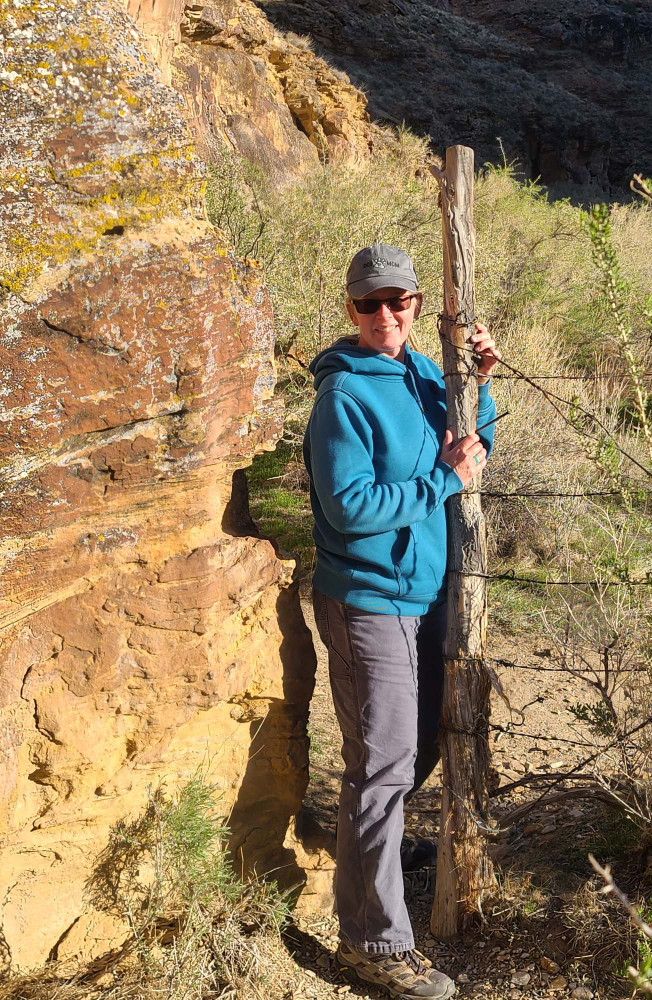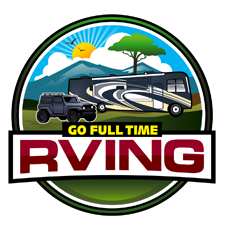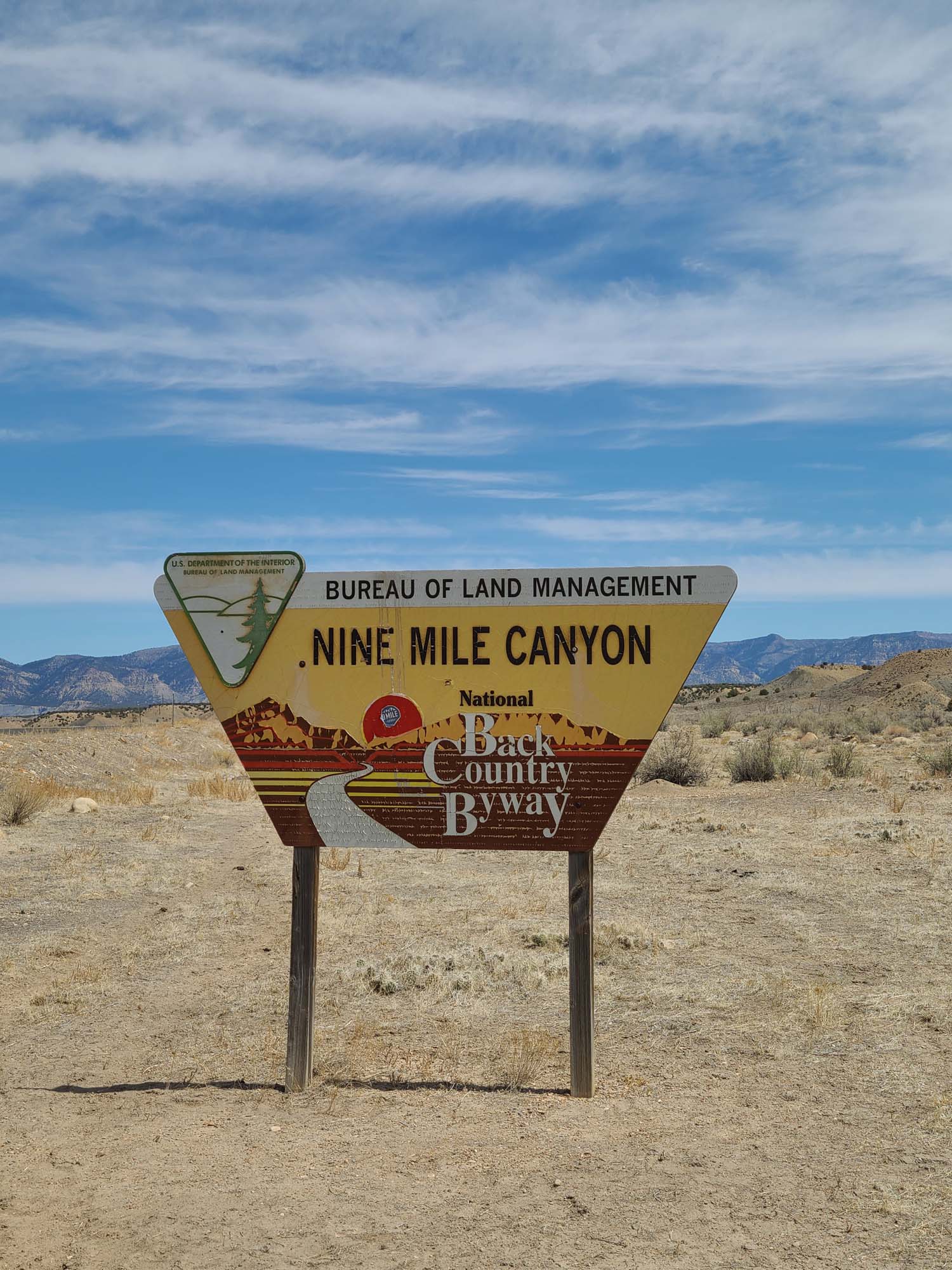Nine Mile Canyon is a relatively unknown area in Utah. As it is not a National Park or Monument, driving Nine Mile Canyon is a trip you have to figure out yourself. During our stay at Blue Cut RV Park, the owner gave us a sheet of 80 stops along Nine Mile Canyon Road. The main attraction of the canyon is the petroglyphs. We also saw a Pronghorn Antelope, 100’s of Mule Deer, Cows, Horses, and Turkeys.

This post contains affiliate links. As a participant in Amazon Associates and various affiliate programs, we are compensated when qualifying purchases are made through our referral links at no additional cost to you. Full Disclosure
This is a cool scavenger hunt. It does take some effort, it’s not a guided tour. For those interested in making their own path and adventure finding the unmarked petroglyphs (and there are so many of them) is a fun day adventure. Very few of the art panels are marked.

We were one of a few cars on this drive….it was miles and miles before we saw another car! Lots of beautiful scenery, petroglyphs, and interesting rock formations. It is described as “the world’s longest art gallery” and is known for its extensive rock art, most of it created by the Fremont culture and the Ute people. Once you figure out where to look you’ll soon see petroglyphs everywhere along the canyon walls.
The rock art, shelters, and granaries left behind by the Fremont make Nine Mile Canyon a popular destination for archaeologists and tourists alike. The section of the canyon with the petroglyphs is about 46 miles long and was a main transport corridor in the region during the 1880s.
Who Created the Petroglyphs
They were built by the Fremont, whose presence in Nine Mile Canyon dates to 950 to 1,250 AD. In fact, the Fremont left irrigation ditches and earthen lodges on the canyon floor that could be seen as late as the 1930s. By the 16th century, the Ute Indians were in the canyon. They added to the rock art already on the walls but in styles of their own. Many scenes depict Ute hunters on horseback and date to the 1800s.
Sites
Along the Nine Mile Canyon Road you’ll drive 21 miles to the entrance to the canyon. From there it’s a few more miles to the first petroglyphs at mile 26.7. There are a few sites marked with signs. These are the easiest-to-find rock art. But look anywhere you see black rock along the canyon wall next to the road you’ll see plenty of others.
Some of our favorite sites along the trip were at Mile 31.3 a petroglyph of a man leading a horse with a rider.

At 32.5, The Balance Rock and Petroglyph “The Juggler”.

We made a stop at the old homestead at Mile 33.3. Here we got out and walked around exploring the old buildings, trucks, tractors, and rock art on the wall behind one of the old trucks. It wasn’t the best panel we saw during the day but exploring the place was fun.


At mile 35 stop in the parking lot across from the county, rock storage shed. Here you’ll find a panel with a couple of owls and a bunch of other drawings.



Our next stop was a nonmarked panel high on the cliff at mile 35.9. At this stop, we parked and climbed the steep embankment to the panel that includes lines, cranes, and goats.


Back down from our climb we jumped back in the Jeep and headed to the Granary pull-off site at Mile 41.8. We had passed a few on our list previously not knowing what a Granary was. At this stop, they have a tube to look through to see the brick-like circular building high on the cliff. We’d recommend binoculars to get a good view of the Granary.
After the Granary stop, we made it to Rasmussen Cave. In the cave are some nice petroglyphs and pictographs. Unfortunately, one very nice large pictograph of a large deer has been vandalized by a property owner writing “This is Private Property No Trespassing” right over the painting.


This brings me to my plea, please, please, please don’t vandalize the area. Don’t add your own rock art, touch the existing art, or carve your name or anything into the rock. This is an amazing place and to see the vandalism that has happened to the area is heartbreaking.
Nearing the end of the trip you come to the Daddy Canyon Complex at Mile 44. At this site, there is parking, a restroom, and picnic tables there as well.
We took a break and had lunch here. From here is a 1/2 mile trail leading past a number of rock art examples; they aren’t signed, so scan the rock-canyon walls from ground level up maybe 20 feet as you walk. The first two are very close to the beginning of the trail on the left.

Others may be found by seeing where others have left the main trail and approached the canyon walls on the right. Stay to the right and follow the cliff back toward the road, then circle back to the parking lot. We went up the canyon at first and didn’t see any petroglyphs in that direction.



Further up the road at Mile 46.1 is signed parking for the “Big Buffalo”. Definitely stop here and see this beautiful artwork. While here find the fence that is at the cliff. Shimmy through the gap between the fence and cliff and follow the trail for a special surprise. We started down the trail and were told by a gentleman with a group of people that it was private property. I didn’t understand since there were BLM trail marker posts, but we turned around and left.


After being run off at the Big Buffalo we headed to the most famous art panel in the area, “The Great Hunt”. This panel is amazing. Scholars believe this panel may represent an actual hunting event. The beautiful execution, detailed design, and well-preserved condition make this panel one of the most recognized and famous rock art sites in Utah. The piece has been featured in a number of publications.

Once we finished viewing The Great Hunt we started back down the canyon stopping again at the Big Buffalo site (since the guy that ran us off was gone). Taking the trail back to the Big Buffalo, following the canyon wall to the left (and squeezing between the rocks and a fence) you’ll soon come to a few pictographs. We followed the trail further and did run into the No Trespassing signs so you’re safe up to that point. Glad we came back.


How to Get There
We took the trip from Wellington but you can also get to it from Myton. For us, we started at the Miller Travel Center Chevron on the corner of Hwy 6/191 and Soldier Creek Rd. From the corner set your odometer to 0 and start up Soldier Creek Rd. Soldier Creek Rd turns into 9 Mile Canyon Rd along the way. Just stay straight and you’ll be fine.
Note: There are NO services after you leave Wellington or Myton, so come prepared. Fuel up, and bring snacks and water.
How Long Does the Trip Take
For us, it took 6½ hours but we made a lot of stops and searched the areas for as many petroglyphs as we could find. Even after spending 6½ hours looking we missed many stops on the list we had and couldn’t find a few that we searched for. You can make the trip longer or shorter depending on how many stops you make.
Conclusion
If you love seclusion this is a great trip to do. There are so many petroglyphs and pictographs on the Nine Mile Canyon drive you could definitely spend days looking at them. This trip is an off-the-beaten-path type of trip and one that we would recommend to anyone with an interest in the Indians that used to call this canyon home.
Thank you for reading our article. If you have any comments or questions we’d love to hear from you below. What interesting places have you been to and can recommend? We’re always looking for neat out-of-the-way places to put on our list of must-sees.




The Nine Mile Canyon looks like non-stopping fun: enormous number of petroglyphs just to start with. The dictionary lets us know that petroglyphs are engraving, and petrographs is painting on rocks instead. The place is located in the United States of America, state of Utah, city of Wellington. Some think immediately of this canyon when they see the expression ‘world’s longest art gallery’. It is 46 miles of petroglyphs…950 to 1,250 AD would be the date of creation of these drawings. They were made by the Fremonts, a pre-Columbian people. Looks like a not-to-be-missed point for archaeologists…congratulations to the author for making us go beyond their text.
Thank you for sharing this beautiful place with us. The rock paintings are amazing and so full of history. What was not amazing is the vandal that wrote over the art 🙁
This is an awesome way to travel and see history and take in the big skies and the beautiful animals.
You are truly blessed!
Thank you for your comments Janine. We have been lucky to see so many interesting places during our travels. We just happened to find out about Nine Mile Canyon which made this adventure even more special.
Do you have a literally hit the spot with this article. Utah is my favorite place in the United States to go to. I know a lot of people may not find a lot of interest in Utah but I personally do! I love going to Utah because of all the many different biomes that they are there. You have officially added to the list of places that I want to visit when I go there again
HI Misael, Thank you for your comments. Utah is one of my favorite places also. We lived in Las Vegas before starting our full time RVing lifestyle, so Utah was close and always a place we’d head for get-a-way weekends.
Thanks for sharing this information about Nine Mile Canyon. The area looks absolutely beautiful and breathtaking. It absolutely broke my heart to see that ancient artwork vandalized though. A sign nearby would have been more than enough to explain that it was private property. It is incredibly disrespectful to the Native Americans who created that art to plaster a “Private property” sign over what is rightfully their property. Absolutely barbaric, but I am glad you and your family had a great time despite the circumstances. I would love to go there myself some day.
Thank you for your comments Rachel! It is a really cool area. The list we got from the campground owner where we’re staying gave us a list of sites that had 80 locations in about 30 miles of road. We hit as many as sounded interesting. We couldn’t find a few of the sites and then found others that weren’t even on the list. It was an amazing day. If you get a chance to go there definitely do it.